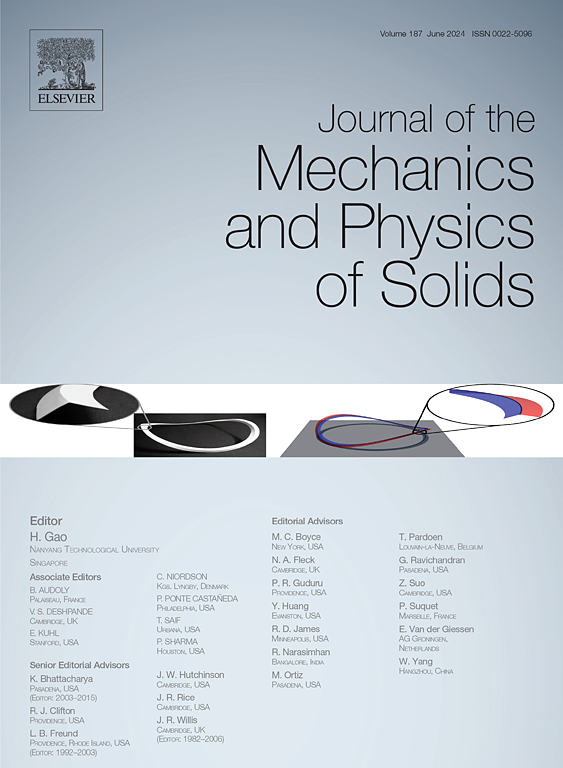Multifidelity analysis of oxidation-driven fracture in ultra-high temperature ceramics
IF 6
2区 工程技术
Q2 MATERIALS SCIENCE, MULTIDISCIPLINARY
引用次数: 0
Abstract
Ultra-High Temperature Ceramics (UHTCs) such as silicon carbide (SiC) typically oxidize in extreme environments, which can result in swelling deformations and internal stresses that cause fracture. In this paper, we present two approaches to computationally model this class of technical ceramic failures, and we apply them to SiC. First, a thermodynamically-consistent continuum theory of thermo-chemo-mechanics is specialized to describe thermally-activated oxidation-induced swelling in UHTCs. In transport-limited cases, the specialized model is shown to capture the molecular diffusion of oxidant through the reaction product layer using only fundamental transport properties, i.e. without the need for calibration to reaction experiments. Second, a phenomenological model is presented that can be calibrated to passive oxidation experiments or alternatively to the fundamental model. We use this second approach to analyze oxidation-induced swelling, delamination and fracture in SiC. We implement both models in a computational discontinuous Galerkin (DG) interfacial multiphysics framework, which enables the analysis of enhanced oxidation along fractured surfaces as well as oxidation-driven fracture. We conduct simulations that provide a full description of the progression of the delamination front. Among the important new insights obtained from the analyses, we infer a direct functional dependence between the temperature-dependent oxidant diffusivity and the delamination rate.
超高温陶瓷氧化断裂的多保真度分析
超高温陶瓷(UHTCs)如碳化硅(SiC)通常在极端环境中氧化,这可能导致膨胀变形和内应力导致断裂。在本文中,我们提出了两种计算方法来模拟这类技术陶瓷失效,并将它们应用于碳化硅。首先,热化学力学的热力学一致连续统理论专门用于描述高温碳化物中热活化氧化引起的膨胀。在传输受限的情况下,专用模型仅使用基本传输特性即可捕获氧化剂通过反应产物层的分子扩散,即无需对反应实验进行校准。其次,提出了一种现象学模型,可以校准为被动氧化实验或替代基本模型。我们使用第二种方法来分析SiC中氧化引起的肿胀、分层和断裂。我们在计算不连续Galerkin (DG)界面多物理场框架中实现了这两个模型,该框架可以分析裂缝表面的增强氧化以及氧化驱动的裂缝。我们进行模拟,以提供对分层锋的进展的完整描述。在从分析中获得的重要新见解中,我们推断出温度依赖性氧化剂扩散率与分层率之间的直接功能依赖关系。
本文章由计算机程序翻译,如有差异,请以英文原文为准。
求助全文
约1分钟内获得全文
求助全文
来源期刊
CiteScore
9.80
自引率
9.40%
发文量
276
审稿时长
52 days
期刊介绍:
The aim of Journal of The Mechanics and Physics of Solids is to publish research of the highest quality and of lasting significance on the mechanics of solids. The scope is broad, from fundamental concepts in mechanics to the analysis of novel phenomena and applications. Solids are interpreted broadly to include both hard and soft materials as well as natural and synthetic structures. The approach can be theoretical, experimental or computational.This research activity sits within engineering science and the allied areas of applied mathematics, materials science, bio-mechanics, applied physics, and geophysics.
The Journal was founded in 1952 by Rodney Hill, who was its Editor-in-Chief until 1968. The topics of interest to the Journal evolve with developments in the subject but its basic ethos remains the same: to publish research of the highest quality relating to the mechanics of solids. Thus, emphasis is placed on the development of fundamental concepts of mechanics and novel applications of these concepts based on theoretical, experimental or computational approaches, drawing upon the various branches of engineering science and the allied areas within applied mathematics, materials science, structural engineering, applied physics, and geophysics.
The main purpose of the Journal is to foster scientific understanding of the processes of deformation and mechanical failure of all solid materials, both technological and natural, and the connections between these processes and their underlying physical mechanisms. In this sense, the content of the Journal should reflect the current state of the discipline in analysis, experimental observation, and numerical simulation. In the interest of achieving this goal, authors are encouraged to consider the significance of their contributions for the field of mechanics and the implications of their results, in addition to describing the details of their work.

 求助内容:
求助内容: 应助结果提醒方式:
应助结果提醒方式:


